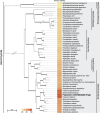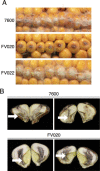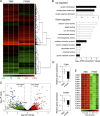The novel fungal-specific gene FUG1 has a role in pathogenicity and fumonisin biosynthesis in Fusarium verticillioides
- PMID: 27071505
- PMCID: PMC6638258
- DOI: 10.1111/mpp.12414
The novel fungal-specific gene FUG1 has a role in pathogenicity and fumonisin biosynthesis in Fusarium verticillioides
Abstract
Fusarium verticillioides is a globally important pathogen of maize, capable of causing severe yield reductions and economic losses. In addition, F. verticillioides produces toxic secondary metabolites during kernel colonization that pose significant threats to human and animal health. Fusarium verticillioides and other plant-pathogenic fungi possess a large number of genes with no known or predicted function, some of which could encode novel virulence factors or antifungal targets. In this study, we identified and characterized the novel gene FUG1 (Fungal Unknown Gene 1) in F. verticillioides through functional genetics. Deletion of FUG1 impaired maize kernel colonization and fumonisin biosynthesis. In addition, deletion of FUG1 increased sensitivity to the antimicrobial compound 2-benzoxazolinone and to hydrogen peroxide, which indicates that FUG1 may play a role in mitigating stresses associated with host defence. Transcriptional profiling via RNA-sequencing (RNA-seq) identified numerous fungal genes that were differentially expressed in the kernel environment following the deletion of FUG1, including genes involved in secondary metabolism and mycelial development. Sequence analysis of the Fug1 protein provided evidence for nuclear localization, DNA binding and a domain of unknown function associated with previously characterized transcriptional regulators. This information, combined with the observed transcriptional reprogramming in the deletion mutant, suggests that FUG1 represents a novel class of fungal transcription factors or genes otherwise involved in signal transduction.
Keywords: DIMBOA; Fusarium ear rot; benzoxazinoids; gene regulation; mycotoxin.
© 2016 BSPP AND JOHN WILEY & SONS LTD.
Figures






Similar articles
-
Fusarium verticillioides SGE1 is required for full virulence and regulates expression of protein effector and secondary metabolite biosynthetic genes.Mol Plant Microbe Interact. 2014 Aug;27(8):809-23. doi: 10.1094/MPMI-09-13-0281-R. Mol Plant Microbe Interact. 2014. PMID: 24742071
-
FvSTUA is a Key Regulator of Sporulation, Toxin Synthesis, and Virulence in Fusarium verticillioides.Mol Plant Microbe Interact. 2020 Jul;33(7):958-971. doi: 10.1094/MPMI-09-19-0271-R. Epub 2020 Jun 2. Mol Plant Microbe Interact. 2020. PMID: 32293993
-
Protein phosphatase 2A regulatory subunits perform distinct functional roles in the maize pathogen Fusarium verticillioides.Mol Plant Pathol. 2013 Jun;14(5):518-29. doi: 10.1111/mpp.12023. Epub 2013 Mar 3. Mol Plant Pathol. 2013. PMID: 23452277 Free PMC article.
-
Genomics of Maize Resistance to Fusarium Ear Rot and Fumonisin Contamination.Toxins (Basel). 2020 Jun 30;12(7):431. doi: 10.3390/toxins12070431. Toxins (Basel). 2020. PMID: 32629954 Free PMC article. Review.
-
Secondary Metabolite Gene Regulation in Mycotoxigenic Fusarium Species: A Focus on Chromatin.Toxins (Basel). 2022 Jan 25;14(2):96. doi: 10.3390/toxins14020096. Toxins (Basel). 2022. PMID: 35202124 Free PMC article. Review.
Cited by
-
Current Approaches for Advancement in Understanding the Molecular Mechanisms of Mycotoxin Biosynthesis.Int J Mol Sci. 2021 Jul 23;22(15):7878. doi: 10.3390/ijms22157878. Int J Mol Sci. 2021. PMID: 34360643 Free PMC article. Review.
-
Sphinganine-Analog Mycotoxins (SAMs): Chemical Structures, Bioactivities, and Genetic Controls.J Fungi (Basel). 2020 Nov 24;6(4):312. doi: 10.3390/jof6040312. J Fungi (Basel). 2020. PMID: 33255427 Free PMC article. Review.
-
Modulation of Growth and Mycotoxigenic Potential of Pineapple Fruitlet Core Rot Pathogens during In Vitro Interactions.Toxins (Basel). 2024 Aug 7;16(8):344. doi: 10.3390/toxins16080344. Toxins (Basel). 2024. PMID: 39195754 Free PMC article.
-
Linkage mapping and genome-wide association study reveals conservative QTL and candidate genes for Fusarium rot resistance in maize.BMC Genomics. 2020 May 12;21(1):357. doi: 10.1186/s12864-020-6733-7. BMC Genomics. 2020. PMID: 32398006 Free PMC article.
-
Conservation and Expansion of Transcriptional Factor Repertoire in the Fusarium oxysporum Species Complex.J Fungi (Basel). 2023 Mar 15;9(3):359. doi: 10.3390/jof9030359. J Fungi (Basel). 2023. PMID: 36983527 Free PMC article.
References
-
- Ahmad, S. , Gromiha, M.M. and Sarai, A. (2004) Analysis and prediction of DNA‐binding proteins and their binding residues based on composition, sequence and structural information. Bioinformatics, 20, 477–486. - PubMed
-
- Bacon, C.W. and Hinton, D.M. (1996) Symptomless endophytic colonization of maize by Fusarium moniliforme . Can. J. Bot. 74, 1195–1202.
-
- Bacon, C.W. , Glenn, A.E. and Yates, I.E. (2008) Fusarium verticillioides: managing the endophytic association with maize for reduced fumonisins accumulation. Toxin Rev. 27, 411–446.
Publication types
MeSH terms
Substances
LinkOut - more resources
Full Text Sources
Other Literature Sources

